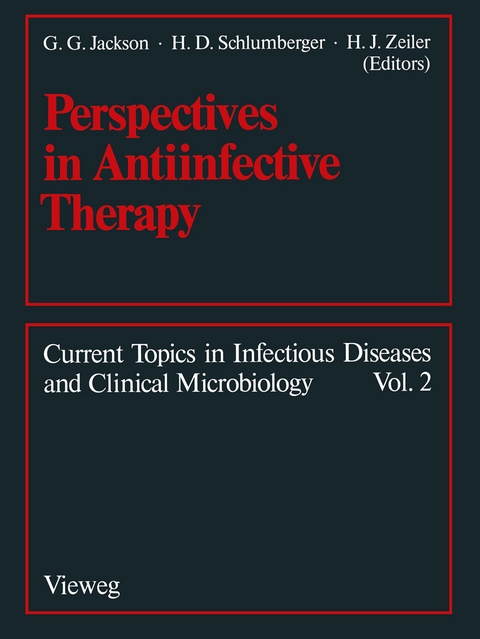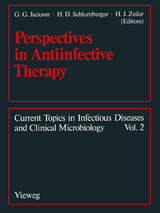Perspectives in Antiinfective Therapy
Vieweg & Teubner (Verlag)
978-3-528-07979-6 (ISBN)
The Challenge of Perspective.- On Bacteriological Research.- Background to Robert Koch's Lecture at the International Congress in Berlin, 1890.- Classical Mechanisms of Antibacterial Drugs.- Multiple Penicillin Binding Protein Profiles in Penicillin Resistant Pneumococci: Evidence for the Clonal Nature of Resistance Among Clinical Isolates.- Antibiotic Uptake into Gram-Negative Bacteria.- Inhibition of Protein Biosynthesis by Antibiotics.- Inhibition of DNA Gyrase: Bacterial Sensitivity and Clinical Resistance to 4-Quinolones.- Mechanisms of Nonbacterial Anti-Infective Drugs.- Mechanisms of Antiretroviral Compounds in Inhibition of Viral and Cellular DNA Polymerase.- Effects of Drugs on Lipids and Membrane Integrity of Fungi.- Membrane Changes Induced by Praziquantel.- Mechanisms of Action of Antimalarial Drugs.- Pathogenic Microbial Mechanisms Susceptible to Drug Application.- Bacterial Adherence in Pathogenicity.- Haemophilus influenzae Gene Expression and Bacterial Invasion.- Coordinate Regulation of Bacterial Virulence Genes.- Microbial Drug Resistance.- Transposon Transfer of Drug Resistance.- Bacterial Proteins Involved in Antimicrobial Drug Resistance.- Persistent Herpes Simplex Virus Infection and Mechanisms of Virus Drug Resistance.- Pharmacology and Drug Delivery.- Antiviral Therapy with Small Particle Aerosols.- Liposomes and Lipid Structures as Carriers of Amphotericin B.- Targeted Liposomes Bearing Sendai for Influenza Envelope Glycoproteins as a Potential Carrier for Protein Molecules and Genes.- Host Determinants in Anti-Infective Chemotherapy.- Cell Mediated Immunity, Immunodeficiency and Microbial Infections.- Neutropenia: Antibiotic Combinations for Empiric Therapy.- Modulation of the Host Flora.- Enhancement of Host Resistance by Control of FungalGrowth.- Nonvaccine Immunoalteration of the Host.- Passive Immunotherapy of Infectious Diseases: Lessons from the Past, Directions for the Future.- T-Cell Mediated Immunopathology in Viral Infections.- New Diseases and Disease Epidemiology.- Adherence and Proliferation of Bacteria on Artificial Surfaces.- Current Knowledge of Chlamydia TWAR, an Important Cause of Pneumonia and Other Acute Respiratory Diseases.- Current Status of Antiviral Chemotherapy for Genital Herpes Simplex Virus Infection: Its Impact on Disease Control.- Induction and Maintenance Therapy for Opportunistic Infections in Patients with AIDS.- New Technology and Drug Design.- Nucleic Acid Hybridization: A Rapid Method for the Diagnosis of Infectious Diseases.- New Technology and Immunospecific Reactions in Helminthic Diseases.- Molecular Targets of Chemotherapeutic Agents Against the Human Immunodeficiency Virus.- Modern Strategies in the Design of Antimicrobial Agents.- Future Development and Use of Anti-Infective Chemotherapy.- The Future Challenge of Infectious Disease.- Barriers to Effective Anti-Infective Therapy: The Perspectives of a Clinical Pharmacologist.- Optimal Use of Antimicrobial Agents.- Views of Future Anti-Infective Therapy (Panel Discussion).
| Erscheint lt. Verlag | 1.1.1989 |
|---|---|
| Zusatzinfo | IX, 299 S. 51 Abb., 1 Abb. in Farbe. |
| Verlagsort | Wiesbaden |
| Sprache | deutsch |
| Maße | 210 x 280 mm |
| Gewicht | 764 g |
| Themenwelt | Medizin / Pharmazie ► Allgemeines / Lexika |
| Medizin / Pharmazie ► Medizinische Fachgebiete ► Pharmakologie / Pharmakotherapie | |
| Studium ► Querschnittsbereiche ► Infektiologie / Immunologie | |
| Schlagworte | AIDS • Antibiotika • Bakterien • Chemotherapie • Droge • Epidemiologie • Forschung • Infektion • Infektionen • Infektionskrankheit • Malaria • Pharmakologie • Therapie • Virus • Zelle |
| ISBN-10 | 3-528-07979-7 / 3528079797 |
| ISBN-13 | 978-3-528-07979-6 / 9783528079796 |
| Zustand | Neuware |
| Haben Sie eine Frage zum Produkt? |
aus dem Bereich




